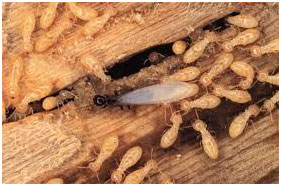Termite Inspection and Treatment Termites Exterminator

Termite Inspection and Treatment Termites Exterminator
Subterranean Termites:
Termites are the only insects that can digest cellulose materials. Subterranean Termites eat mostly the spring wood and leave the summer wood which they cannot effectively digest therefore, the damaged wood appears layered. There is also soil typically found in the galleries.
Subterranean Termite colonies are usually located in the ground. Location is usually below the frost line and above the water table. They can enter structures through cracks less than 1/16”. When they have to cross an open area to get to get to their food source, they build mud tubes that they travel through to protect them. If there is a constant source of moisture, like leaky pipes, they can live above ground and without ground contact.

Here in the Northwest, Subterranean Termites swarm in the fall and usually after it rains. Swarmers are about 3/8” including the wings. These are the ones you see for a couple of days flying out of the ground, stumps, logs; etc. After swarming, they lose their wings, pair up, and construct an appropriate cavity.
They mate within a day of this. An average of 10 eggs is produced this first time and they usually hatch within 50-60 days.
Control involves placing a chemical barrier and / or an in ground monitoring-baiting system between the termites and the wood parts of the structure. In addition, all earth to wood contact needs to be eliminated, and any wood debris removed. Wood moisture content needs to be below 20%.

Dampwood Termites
As the name implies, Dampwood Termites locate their colonies in damp and decaying wood; typically in stumps, logs, or dead standing trees. From these places, they move into structures, especially where there is wood in contact with soil, or there is a constant moisture source such as leaky pipes.
They eat across the grain, consuming both the spring and summer wood. In doing this, they make a series of galleries connected by tunnels whose walls are extremely smooth. There is no soil in the tunnels, but the fecal pellets accumulate in the galleries. They also use these pellets to seal off galleries or wood, similar to the way Subterranean Termites use soil.
Dampwood Termites swarm mainly in the fall in the Northwest. Swarmers are about 1” long including the wings. After swarming, they lose their wings and pair up. Both swarmers excavate a chamber, they enter the chamber, and the chamber is sealed. They mate within 2 weeks and eggs are laid 14-18 days. The queen lays an average of 12 eggs this time. The second batch is laid the next spring.
In general, check for moisture problems and/or decaying wood first, then for Dampwood Termites. Control consists of eliminating the moisture source and all earth to wood contact. Then the infested wood should be replaced.





 Follow
Follow


